How to choose a pumping station for home and garden: useful tips
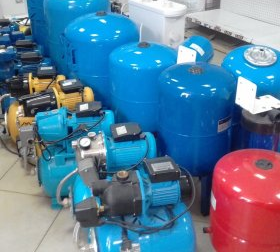
Own water supply system is a necessary condition for comfort in a country house remote from centralized engineering systems. If there is a well or a well on the site, it is not difficult to equip an autonomous water supply system - it is enough to install a domestic pumping station.
Such units are represented in the distribution network very widely - you can buy a product of any capacity and configuration. That's just to make the right choice, it is necessary not only to understand the technical characteristics of pumping stations, but also to take into account many other factors.
Content
Why do we need a pumping station and what are the benefits of installing it?
The main advantage of modern pumping stations (PS) is that with their help you can organize a full-fledged autonomous water supply of a country house, cottage, cottage or restaurant.

For all its compactness, a modern pumping station is able to provide water to a large rural cottage, designed for several families
Although the cost of such equipment involves additional investments compared to a simple centrifugal or vibration pump, the installation of a pumping station, also called hydrophore, has many advantages:
- An opportunity to carry out installation and dismantle of the unit as soon as possible. Due to the fact that the pumping station is an assembled and adjusted device, even a beginner can install and connect it to the water supply.
- Universality. This type of equipment is suitable for taking water from any source - a well, a well, an artificial reservoir or a natural reservoir.
- Water supply. The pumping station includes a hydraulic accumulator, which will provide backup water supply for the period of power outage.
- Work on wells of any size. Using a surface pump and a long intake hose allows water to be pumped out of the wells with a minimum casing diameter.
- High reliability. The switching frequency of the pump, which works in conjunction with the storage tank, decreases several times, which means that its service life and longevity are multiplied.
Against the background of the many advantages of modern NS, small flaws in the form of noise and the need for periodic monitoring and adjustment can be considered insignificant.
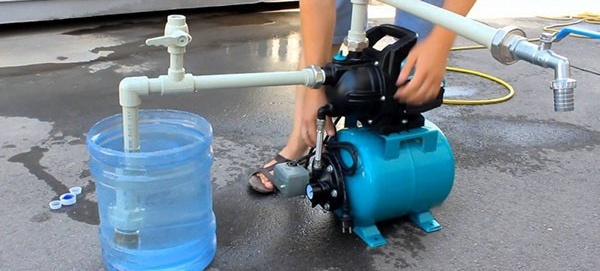
The pump station is a unit that is completely ready for operation, so even a beginner can carry out its installation
Criteria for the selection of pumping stations
To create a truly full-fledged and reliable autonomous water supply system is possible only if, when choosing it, each of the following factors will be taken into account:
- height of rise of water;
- technical characteristics - electric power, pressure and performance:
- accumulator volume;
- materials used;
- reliability of automation;
- installation method.
It is also important which company manufactured the pumping station. Although the brand’s fame affects the cost of equipment, in the end, the right choice will result in reliable, durable work without breakdowns and repairs.
Suction head and type of pumping station
The height of the water rise is one of the most important characteristics of autonomous water supply equipment and has a decisive influence on its cost. According to the type of suction, several types of pumping stations can be distinguished:
- centrifugal or vortex single-stage;
- multi-stage;
- with integrated ejector;
- with remote ejector.
The former have low performance, but provide good pressure. Their main advantage is silent operation and low cost, however, the maximum suction depth of single-stage units is minimal - from 7 m to 8 m.
More information about the internal structure and the principle of operation of the self-priming pump for water can be found here: https://aquatech.tomathouse.com/en/vodosnab/nasos/nasosy-montazh/ustrojstvo-samovsasyvayushhego-nasosa.html
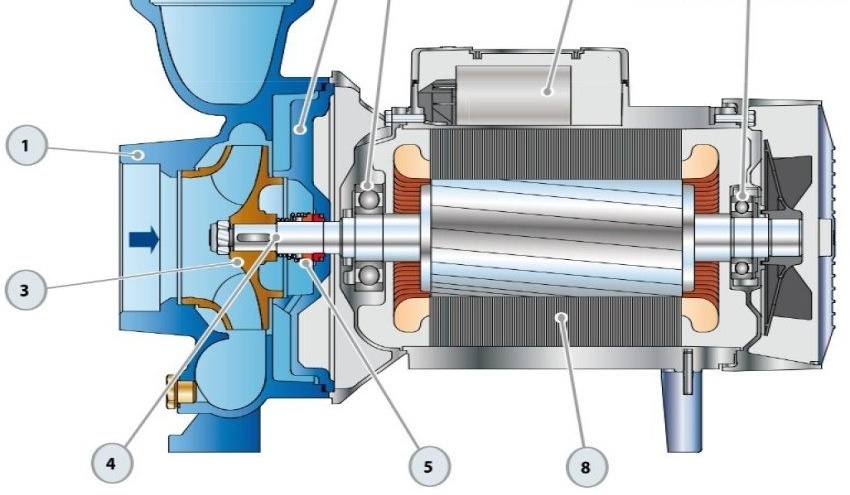
The advantage of single-stage pumps is simplicity and reliability. The design of such an assembly consists of a housing (1), a cover (2), an impeller (3), a drive shaft (4), a sealing gland or sleeve (5), bearings (6), a capacitor (7) and an electric motor (8)
Multistage pumping systems are also designed for surface installation near a source with a depth of not more than 8 m and stand out for their quiet operation, but differ in improved technical characteristics.
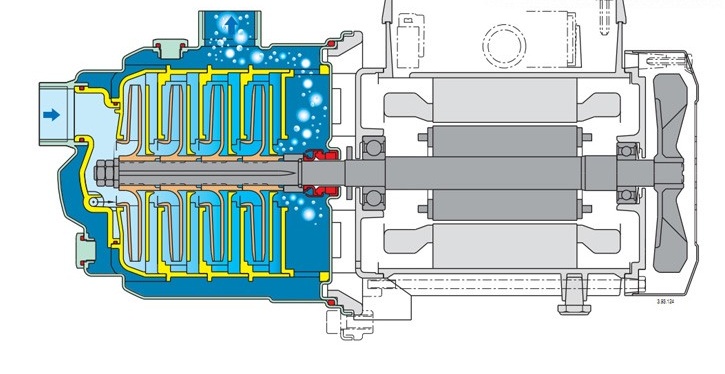
In multi-stage pumps, several impellers are used, due to which it is possible to increase the pressure and productivity
To increase the length of the suction line, pumps of modern plants are equipped with ejection devices. Their principle of operation is that part of the output stream is redirected to the suction line, so manufacturers can significantly extend it. NS with a built-in ejector provide the rise of water from depths up to 10 meters, therefore they are used for open reservoirs, shallow wells and buried tanks.
Showing excellent results in productivity, units with a built-in ejector have a high noise level - a consequence of the flow of water flowing through a tapering nozzle. Most often, simple NSs are installed in pits above wells or in close proximity to sources. If the equipment needs to be installed indoors, then you will have to take care of its sound insulation.
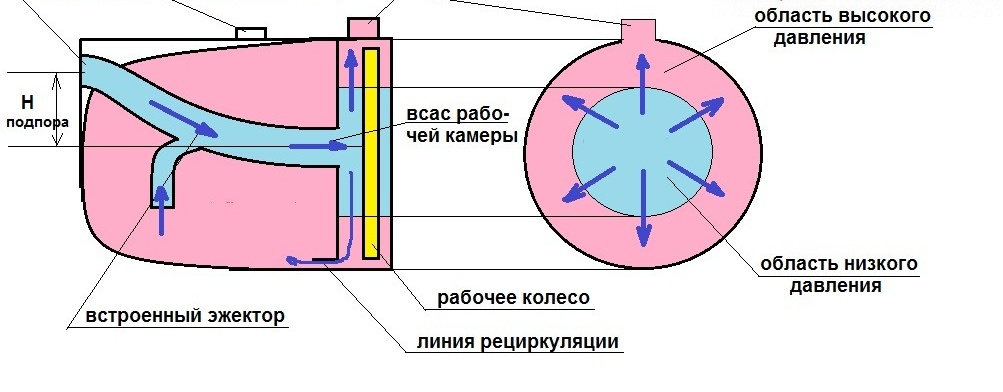
The built-in ejector works on the principles of Bernoulli, providing easier start-up of the pump and creating additional vacuum for lifting water from a great depth
Systems with a remote ejector operate with a minimum noise level and provide a rise of water from depths up to 35 m. In this case, the ejection device can be installed at a distance from the pump station or directly in the source. When choosing an ejector NS of the second type, be prepared for additional expenses. They are associated both with a higher cost of the equipment itself, and with the need to install two parallel pipes - supply and recirculation. This feature should be taken into account at the stage of well design.
The ejector for the pumping station can be assembled with your own hands. How to do this is described in this article:https://aquatech.tomathouse.com/en/vodosnab/nasos/nasos-stancii/ezhektor-dlya-nasosnoj-stancii.html
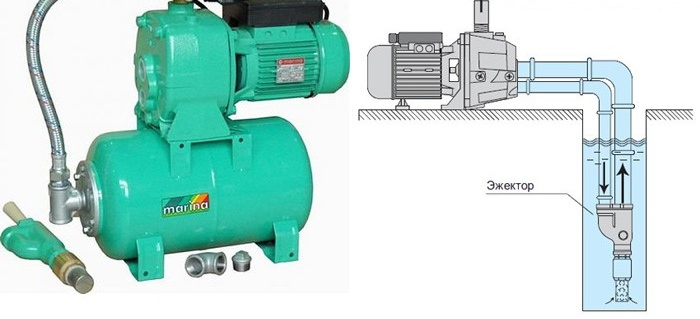
A pump station with an external ejector allows water to be lifted from great depths, but requires the installation of another line for water recirculation
The vast majority of pumping stations are equipped with a hydraulic accumulator, which provides the necessary supply of water and reduces the frequency of switching on the pump. However, there are models without a storage tank - their automation switches on the pump every time a valve opens or a toilet bowl is filled.
The advantage of such units is their compactness, low price and ability to hold stable pressure. Known shortcomings in the form of lack of reserve and frequent switching on of the pump are supplemented by high requirements for connecting parts and other water supply elements - they must cope with high pressure and water hammer.

The pump station without a hydraulic accumulator includes a pressure regulator that will turn on the pump every time you open the faucet in the kitchen or in the bathroom
Specifications
The main technical characteristics of the pumping station are pressure and capacity. It depends on these parameters whether the equipment can provide the required water pressure in the system, as well as whether its quantity is sufficient if several flow valves are opened at the same time.
Information on a particular brand of pumping station can be found in the product data sheet - the manufacturer indicates them on the first pages of the manual.
| Comparative characteristics of popular pumping stations | |||
|---|---|---|---|
| Model of a household pumping station | Productivity, cubic m / hour | Maximum head, m | Electric power, kW |
| Grundfos Hydrojet, JP 5-24 | 3.5 | 40 | 0.775 |
| General Pump GP, J-804SA5 | 3 | 42 | 0.8 |
| Water technology, RGP 1203/60 | 3 | 45 | 0.75 |
| Hurricane GARP, 1200S | 3.8 | 48 | 1.2 |
| Jumbo, 60 / 35P-K | 3.6 | 35 | 0.6 |
| Frequency system, Water cannon 115/754 | 4.2 | 75 | 1.65 |
| NeoClima, GP 600/20 N | 3 | 3 | 0.6 |
| Quattro Elementi Automatico 801 | 5.3 | 4 | 0.8 |
Pressure
If you wondered what the pump flow should be, then the required characteristics can be calculated independently. So, the pressure is determined by the formula H = (Hn + Hi + L / 10 + Hd), where Hn is the nominal water pressure in the system (1.5-3 bar), Hi is the suction depth, L is the length of the horizontal section of the pipeline from the pump to the house , Hd - the height of the supply points above the level of the laying of the supply line.
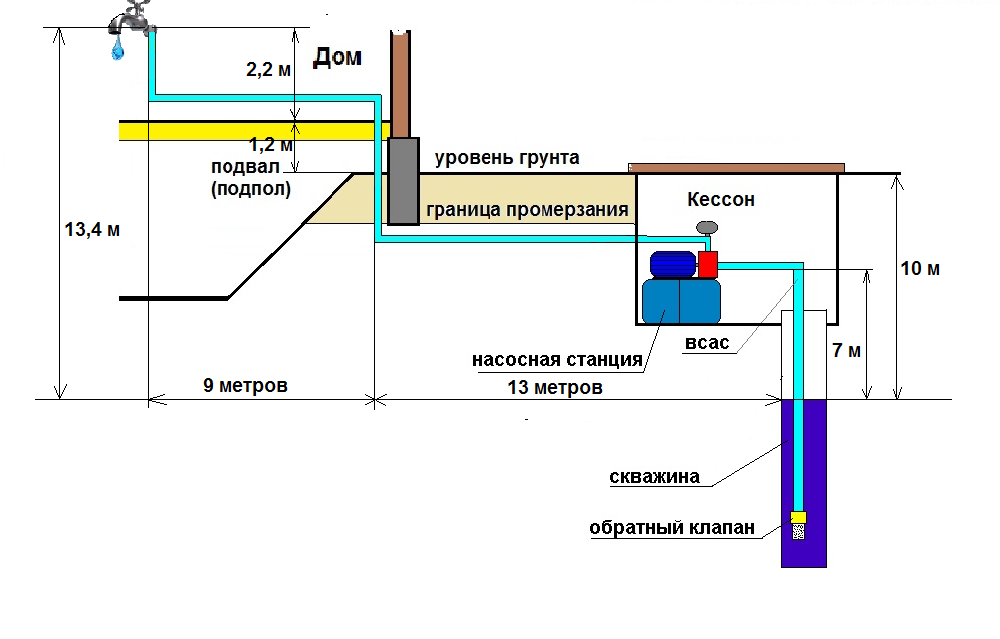
A simple calculation with the linear parameters of the water supply system will help to make a hydraulic calculation to determine the pressure characteristic of the pump
Performance
Determining the volume of water that the pumping station must supply per unit time is also not difficult. To do this, calculate the number of all instantly open consumables (faucets in the kitchen and in the bathroom plus a toilet bowl) and determine the total amount of water in liters that must pass through them per minute. To bring this value to a standard value (cubic meters / hour), it should be divided by 1000 and multiplied by 60 (for example, 20 l / min = 20/1000 × 60 = 1.2 cubic meters / hour).
Since the pressure and productivity are in a non-linear relationship with each other, equipment manufacturers often provide information on its technical characteristics in the form of a graph.
When calculating productivity and pressure, you should not discount the possibility of a water source. If the debit of the well or well is lower than the consumption value, then negative moments such as severe pressure drops, intermittent water supply, automatic pump shutdown of the pump, or equipment failure can occur.
The power of its electric motor depends on the performance of the pump - most often this parameter is in the range of 500 W - 2 kW (for domestic pumping stations). It will not work to save electricity by choosing a low-power switch - in the best case, a thin stream will pour at the outlet of the mixer spout.
The only thing I would like to recommend is not to buy a unit with a large supply in terms of pressure and the amount of pumped water. A pumping station that meets the design capacity will have optimal power, which means that you, one way or another, will avoid unnecessary expenses for electricity.
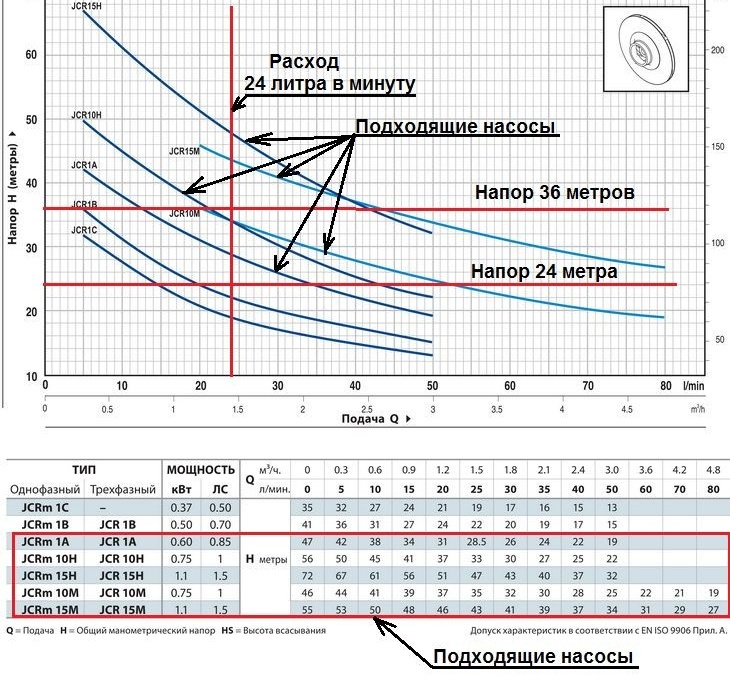
Knowing the pressure and performance, it is not difficult to determine the specific model of the pumping station of a particular manufacturer - this will help summary schedules of the technical characteristics of their products
Storage tank volume
The frequency of turning on the pump and the reserve amount of water in case of a power outage depend on the size of the accumulator. The first factor affects the durability of the electric motor of the unit, since the danger of breakdown of its electrical windings most often occurs during start-up. This is due to the fact that at this time the current strength reaches maximum values. The water supply in the house is also of great importance, however, in either case, it should be remembered that the price of the accumulator and its capacity are connected by an almost linear relationship.
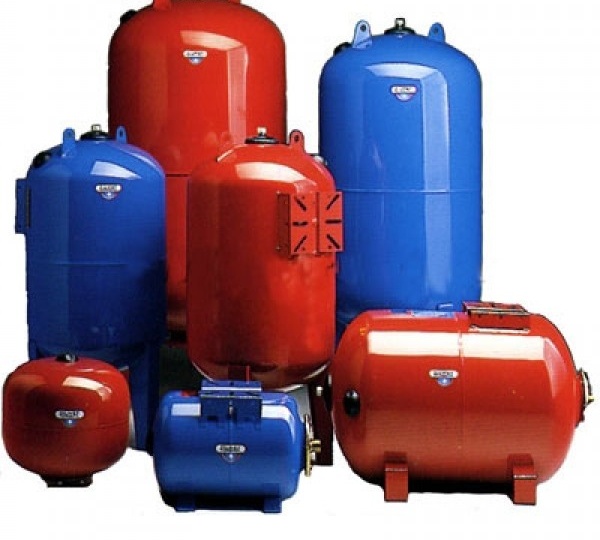
The industry produces hydraulic accumulators of any size, so in case of frequent blackouts, the pumping station can be equipped with a larger tank
You should not think that a 50-liter storage tank contains just such an amount of water. The fact is that the tank consists of two chambers, one of which is occupied by liquid, and the other is air pumped into the storage tank.

Despite the simplest design, the accumulator performs important functions - eliminates water hammer, reduces the frequency of pump starts and allows you to create a reserve supply of water
Depending on the pressure in the air chamber, which can vary between 0.8 - 4 atm and the settings of the pressure switch, the usable volume can be from 30 to 45% of the tank capacity.
| The size of the internal volume of the accumulator depending on the parameters of the pumping stations and the pressure in the air chamber | ||||||||||||
|---|---|---|---|---|---|---|---|---|---|---|---|---|
| P air bar | 0.8 | 0.8 | 1.8 | 1.3 | 1.3 | 1.8 | 1.8 | 2.3 | 2.3 | 2.8 | 2.8 | 4.0 |
| P on us bar | 1.0 | 1.0 | 2.0 | 1.5 | 1.5 | 2.0 | 2.0 | 2.5 | 2.5 | 3.0 | 4.0 | 5.0 |
| P off us bar | 2.0 | 2.5 | 3.0 | 2.5 | 3.0 | 2.5 | 4.0 | 4.0 | 5.0 | 5,0 | 8.0 | 10.0 |
| Total tank volume, l | Water supply, l | |||||||||||
| 19 | 5.7 | 7.33 | 4.43 | 4.99 | 6.56 | 2.53 | 7.09 | 5.37 | 7.46 | 6.02 | 8.11 | 8.35 |
| 24 | 7.2 | 9.26 | 5.6 | 6.31 | 8.28 | 3.2 | 8.96 | 6.79 | 9.43 | 7.6 | 10.24 | 1.55 |
| 50 | 15.00 | 19.29 | 1.67 | 13.14 | 17.25 | 6.67 | 18,67 | 14.14 | 19.64 | 15.83 | 21.33 | 21.97 |
| 60 | 18.00 | 23.14 | 14.0 | 15.77 | 20.7 | 8.0 | 22.4 | 16.97 | 23.57 | 19.0 | 25.6 | 23.36 |
| 80 | 24.0 | 30.86 | 18.67 | 21.03 | 27.6 | 10,67 | 29.87 | 22.63 | 31.43 | 25.33 | 34.13 | 35.15 |
| 100 | 30.0 | 38.57 | 23,33 | 26.29 | 34.50 | 13.33 | 37.33 | 28.29 | 39.29 | 31.67 | 42.67 | 43.94 |
| 200 | 60.0 | 77.14 | 46.67 | 52.57 | 69.0 | 26.67 | 74.67 | 56,57 | 78.57 | 63.33 | 85.33 | 87.88 |
You can find out how to adjust the pressure in the accumulator of a pumping station from an article posted in another section of our website:https://aquatech.tomathouse.com/en/vodosnab/nasos/nasos-stancii/regulirovka-rele-davleniya-dlya-nasosa.html
Video: How to correctly calculate the volume of the accumulator
Materials of manufacture
In the distribution network you can find pumps with the same technical characteristics and cost, which in some cases differs several times. The thing is that manufacturers use various materials, and this affects both the durability of the equipment and its reliability. So, the accumulators of household pumping stations are most often made of black or stainless steel sheet. The latter excellently resist corrosion and have a maximum service life, but have a higher cost.
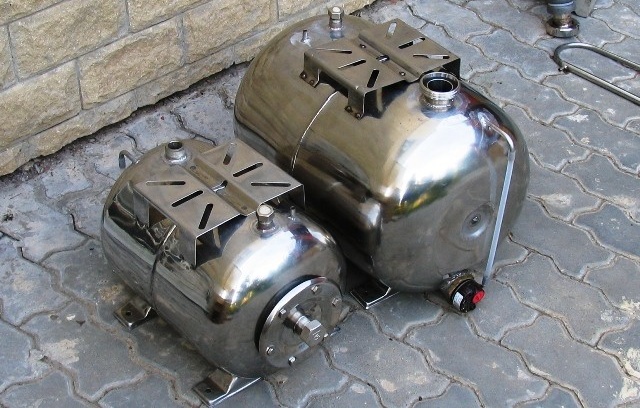
When installing a pumping station in a damp pit or in a wet basement, a stainless steel accumulator cannot be dispensed with - in such conditions, simple steel rusts over several years
It is also important what material the pump casing and its impellers are made of. If it is plastic, then you will pay inexpensively, however, you should not count on the long-term operation of the unit. The middle-class equipment parts are made of steel and cast iron, so it has good quality at a moderate cost.
Aluminum, brass and bronze are used to manufacture the body and components of pumping stations of the highest category, so they are characterized by maximum durability. Of course, the use of non-ferrous metals leaves its mark on the price of equipment - be prepared to pay a tidy sum.
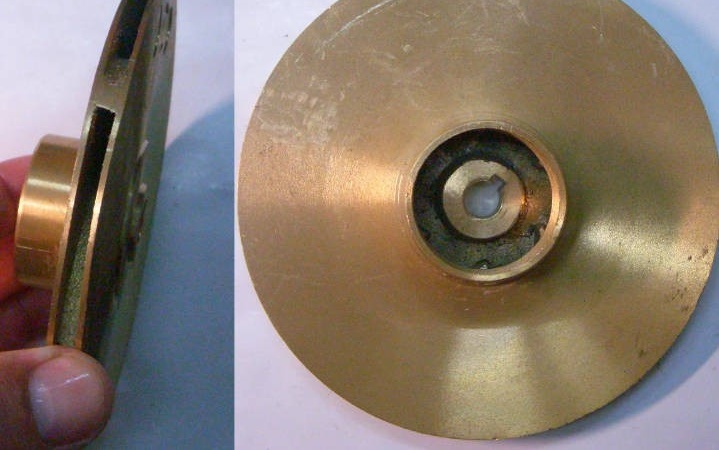
Premium-class brass impellers of pumps do not corrode during the entire service life, therefore they are the key to long-term, reliable operation
Automation of pumping stations
Each pump station includes a pressure switch - a device that is responsible for turning the pump on and off. Relays of famous manufacturers are distinguished by a reinforced contact group, a stainless steel membrane chamber and high quality of other parts. During operation, they do not require intervention in the work. Cheap start-up and control equipment suffers from such phenomena as corrosion of individual parts, weakening of spring assemblies, burning contacts, etc., therefore, they require periodic adjustment or repair.
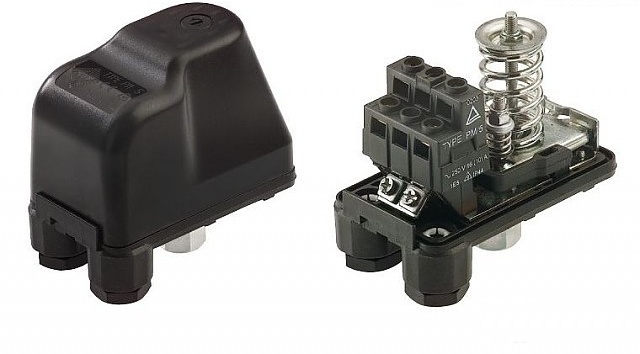
The pressure switch is responsible for the timely on and off of the pump, which, due to its simplicity, has high reliability
To increase the reliability of the units, manufacturers equip them with a system of protection against dry running and overheating. The first system will turn off the power to the pump if, for some reason, water is lost in the supply line. The thermal relay will prevent combustion or breakdown of the windings of the electric motor when the power unit is heated above the permissible temperature. Although protective systems increase the cost of equipment, they should not be abandoned, especially if it is planned to supply water from a source with limited debit.
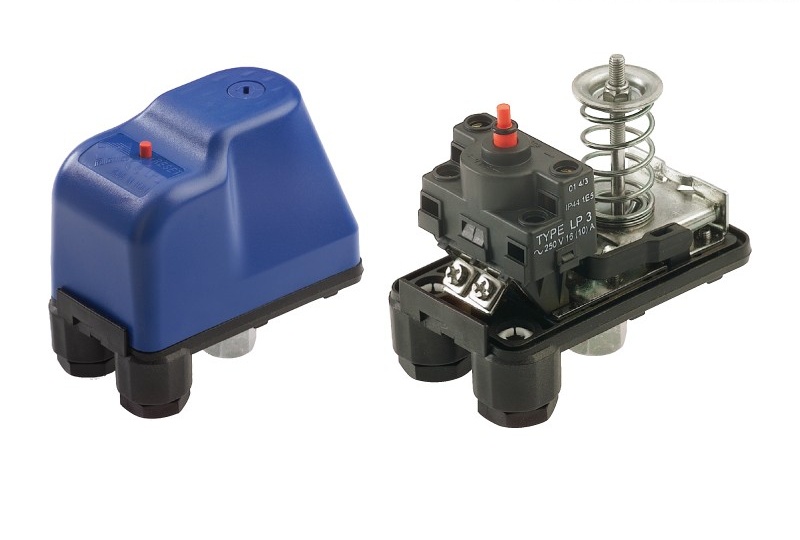
The dry running sensor is very similar in appearance to a pressure switch. Only the button indicates the purpose of the device, indicating the need to manually turn on the device after an emergency operation
Installation method
According to the type of installation, pumping stations are divided into two types:
- surface location - installed in a house or near a water source - in a ground structure or pit;
- buried units, which incorporate a deep pump and provide water lifting from depths up to 300 m (such NSs are more likely to be professional equipment).
Any home foreman can install a surface type pumping station. As for the submersible equipment, it is better to entrust its installation to professionals.
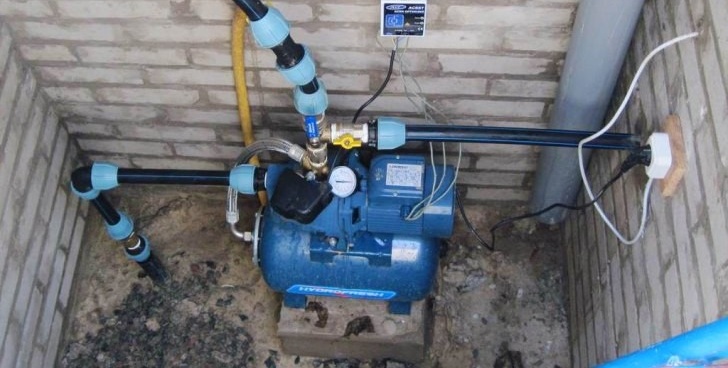
Most pumping stations require installation near the well, since the length of their suction line does not exceed 8-10 m
Comparative characteristics of pumping stations
To facilitate the selection of pumping equipment, you can use the table with data on its technical characteristics and features.
As for the parameters of units for autonomous water supply of a particular brand, each company provides comprehensive information on the models produced and their technical characteristics. You can familiarize yourself with the parameters of several of the most popular pumping stations from the table below.
Which pumping station to choose
It is no coincidence that pumping equipment of popular brands has a higher cost than units of lesser-known manufacturers. Serious companies invest not only in production, but also develop technology. In addition, not a single manufacturer that has been building its reputation for decades will allow itself to use low-quality materials - this is what little-known brands suffer in an attempt to attract customers at a low price.

High manufacturability, high-quality materials and assembly culture distinguish branded equipment among hundreds of units of other, less well-known companies
The water supply station is best chosen in the assortment of manufacturers Grundfos, Pedrollo, Gardena, Metabo, Wilo and other European companies.
Armed with knowledge and making the necessary calculations, feel free to go to the store for a brand new pumping station. If you still have any questions, then ask them through the feedback form. The experts of our site will provide expert assistance in the shortest possible time.

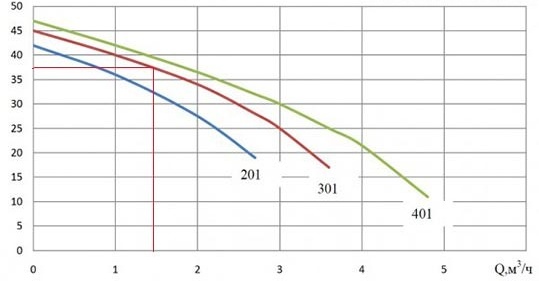

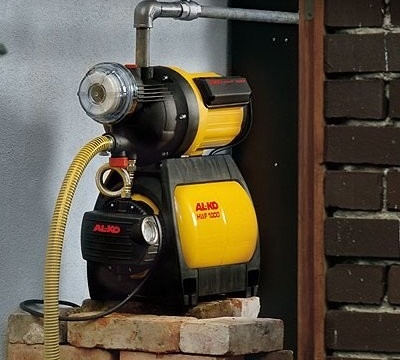


5 comments